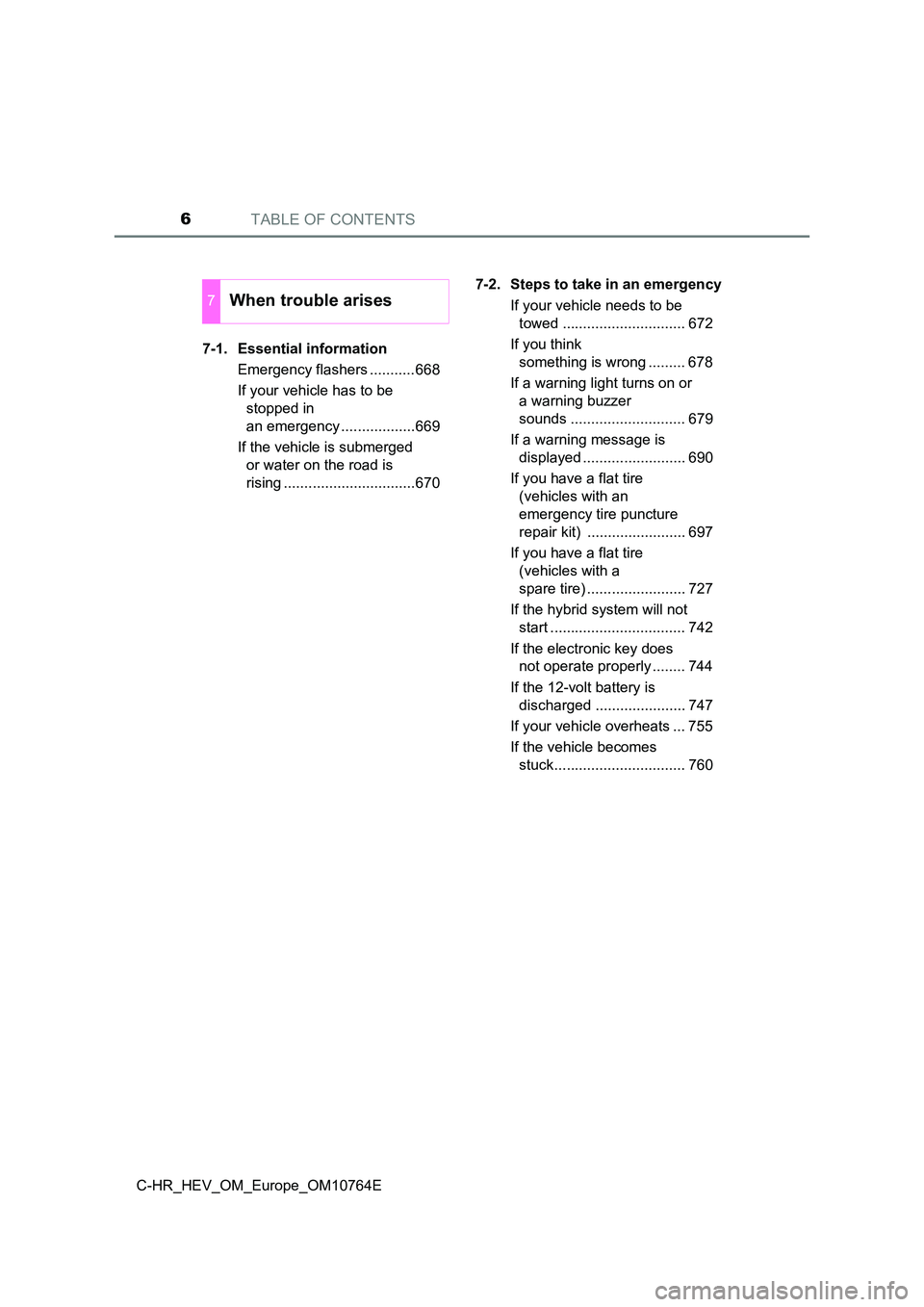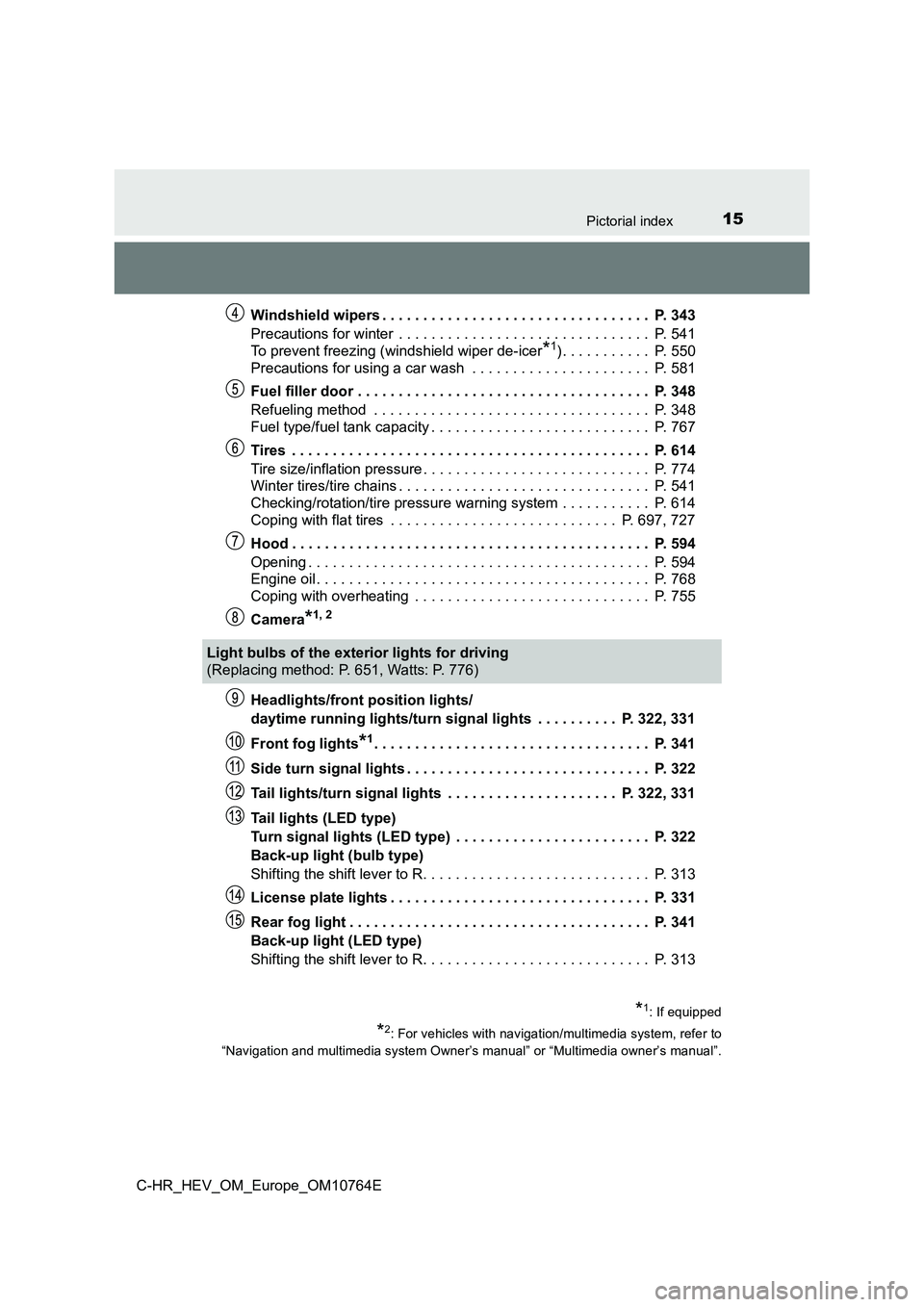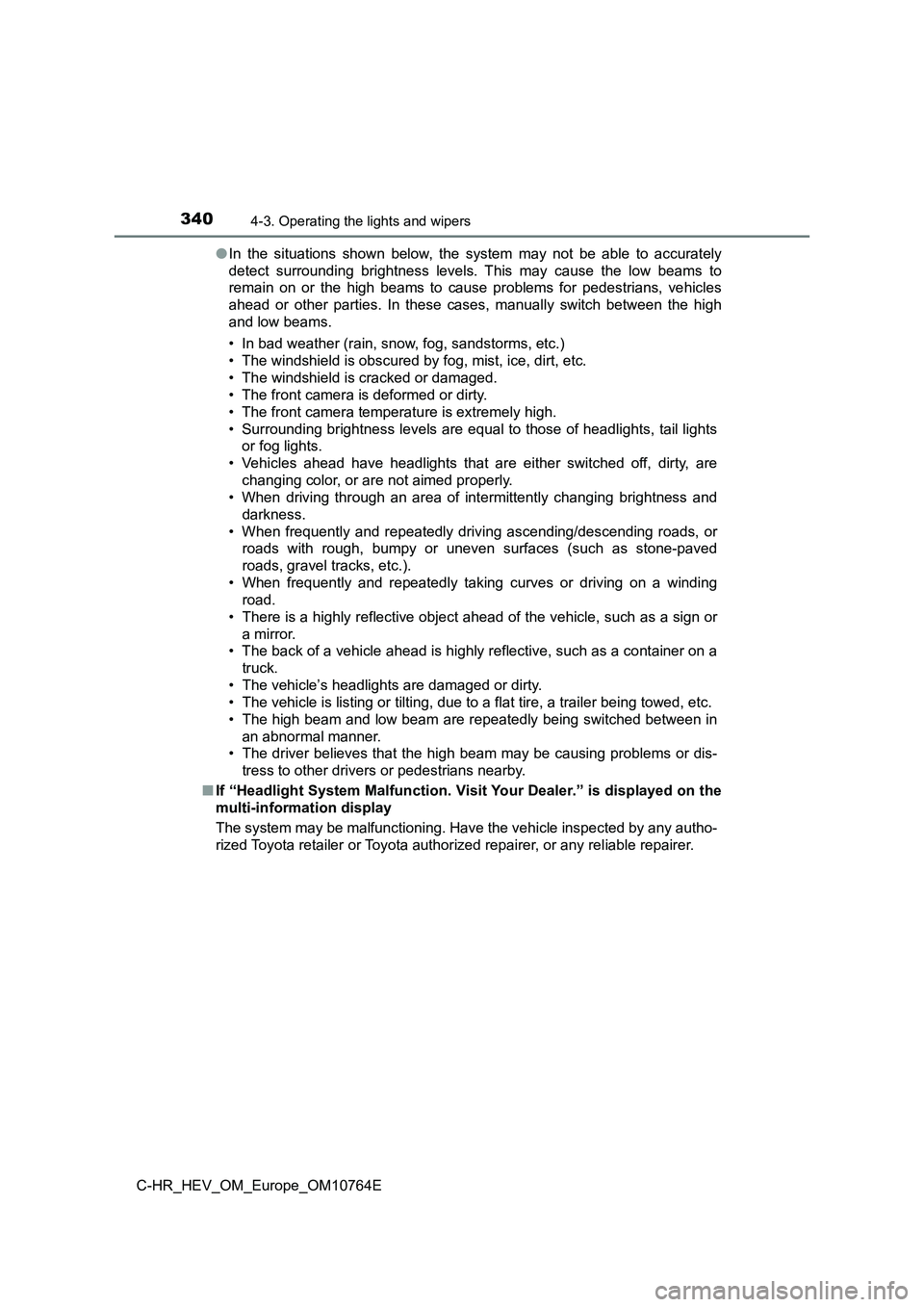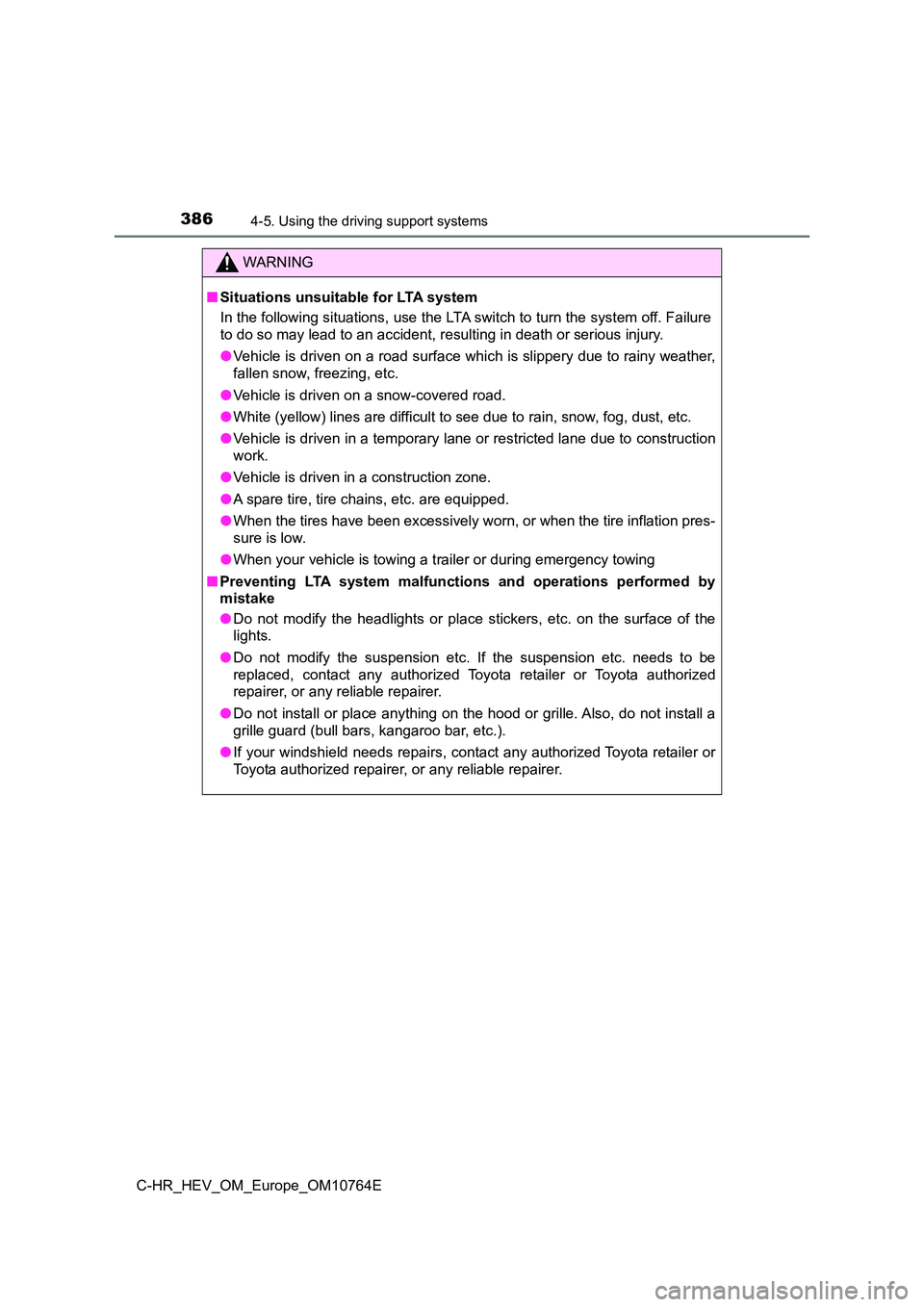flat tire TOYOTA C-HR 2023 Owners Manual
[x] Cancel search | Manufacturer: TOYOTA, Model Year: 2023, Model line: C-HR, Model: TOYOTA C-HR 2023Pages: 814, PDF Size: 112.62 MB
Page 7 of 814

5
1
5
4
3
2
C-HR_HEV_OM_Europe_OM10764E
8
7
6
5-1. Using the air conditioning
system and defogger
Air conditioning system ......546
Heated steering wheel/
seat heaters .....................555
5-2. Using the interior lights
Interior lights list .................557
• Interior lights ..................558
• Personal lights ...............558
5-3. Using the storage
features
List of storage features ......560
• Glove box ......................561
• Console box ..................561
• Bottle holders ................562
• Cup holders ...................563
Luggage compartment
features............................564
5-4. Using the other interior
features
Other interior features ........572
• Sun visors ......................572
• Vanity mirrors ................572
• Clock .............................573
• Power outlet ..................574
• Assist grips ....................575
6-1. Maintenance and care
Cleaning and protecting the
vehicle exterior ................ 578
Cleaning and protecting the
vehicle interior ................. 584
6-2. Maintenance
Maintenance
requirements ................... 588
6-3. Do-it-yourself
maintenance
Do-it-yourself service
precautions ..................... 591
Hood.................................. 594
Positioning a floor jack ...... 596
Engine compartment ......... 597
12-volt battery
(M20A-FXS engine) ........ 610
Tires .................................. 614
Tire inflation pressure........ 630
Wheels .............................. 632
Air conditioning filter .......... 635
Hybrid battery
(traction battery)
air intake vent and filter ... 638
Electronic key battery ........ 643
Checking and replacing
fuses ............................... 646
Light bulbs ......................... 651
5Interior features6Maintenance and care
Page 8 of 814

TABLE OF CONTENTS6
C-HR_HEV_OM_Europe_OM10764E
7-1. Essential information
Emergency flashers ...........668
If your vehicle has to be
stopped in
an emergency ..................669
If the vehicle is submerged
or water on the road is
rising ................................670
7-2. Steps to take in an emergency
If your vehicle needs to be
towed .............................. 672
If you think
something is wrong ......... 678
If a warning light turns on or
a warning buzzer
sounds ............................ 679
If a warning message is
displayed ......................... 690
If you have a flat tire
(vehicles with an
emergency tire puncture
repair kit) ........................ 697
If you have a flat tire
(vehicles with a
spare tire) ........................ 727
If the hybrid system will not
start ................................. 742
If the electronic key does
not operate properly ........ 744
If the 12-volt battery is
discharged ...................... 747
If your vehicle overheats ... 755
If the vehicle becomes
stuck................................ 760
7When trouble arises
Page 17 of 814

15Pictorial index
C-HR_HEV_OM_Europe_OM10764E
Windshield wipers . . . . . . . . . . . . . . . . . . . . . . . . . . . . . . . . . P. 343
Precautions for winter . . . . . . . . . . . . . . . . . . . . . . . . . . . . . . . P. 541
To prevent freezing (windshield wiper de-icer*1) . . . . . . . . . . . P. 550
Precautions for using a car wash . . . . . . . . . . . . . . . . . . . . . . P. 581
Fuel filler door . . . . . . . . . . . . . . . . . . . . . . . . . . . . . . . . . . . . P. 348
Refueling method . . . . . . . . . . . . . . . . . . . . . . . . . . . . . . . . . . P. 348
Fuel type/fuel tank capacity . . . . . . . . . . . . . . . . . . . . . . . . . . . P. 767
Tires . . . . . . . . . . . . . . . . . . . . . . . . . . . . . . . . . . . . . . . . . . . . P. 614
Tire size/inflation pressure . . . . . . . . . . . . . . . . . . . . . . . . . . . . P. 774
Winter tires/tire chains . . . . . . . . . . . . . . . . . . . . . . . . . . . . . . . P. 541
Checking/rotation/tire pressure warning system . . . . . . . . . . . P. 614
Coping with flat tires . . . . . . . . . . . . . . . . . . . . . . . . . . . . P. 697, 727
Hood . . . . . . . . . . . . . . . . . . . . . . . . . . . . . . . . . . . . . . . . . . . . P. 594
Opening . . . . . . . . . . . . . . . . . . . . . . . . . . . . . . . . . . . . . . . . . . P. 594
Engine oil . . . . . . . . . . . . . . . . . . . . . . . . . . . . . . . . . . . . . . . . . P. 768
Coping with overheating . . . . . . . . . . . . . . . . . . . . . . . . . . . . . P. 755
Camera*1, 2
Headlights/front position lights/
daytime running lights/turn sig nal lights . . . . . . . . . . P. 322, 331
Front fog lights*1. . . . . . . . . . . . . . . . . . . . . . . . . . . . . . . . . . P. 341
Side turn signal lights . . . . . . . . . . . . . . . . . . . . . . . . . . . . . . P. 322
Tail lights/turn signal lights . . . . . . . . . . . . . . . . . . . . . P. 322, 331
Tail lights (LED type)
Turn signal lights (LED type) . . . . . . . . . . . . . . . . . . . . . . . . P. 322
Back-up light (bulb type)
Shifting the shift lever to R. . . . . . . . . . . . . . . . . . . . . . . . . . . . P. 313
License plate lights . . . . . . . . . . . . . . . . . . . . . . . . . . . . . . . . P. 331
Rear fog light . . . . . . . . . . . . . . . . . . . . . . . . . . . . . . . . . . . . . P. 341
Back-up light (LED type)
Shifting the shift lever to R. . . . . . . . . . . . . . . . . . . . . . . . . . . . P. 313
Light bulbs of the exterior lights for driving
(Replacing method: P. 651, Watts: P. 776)
*1: If equipped
*2: For vehicles with navigation/multimedia system, refer to
“Navigation and multimedia system Owner’s manual” or “Multimedi a owner’s manual”.
Page 293 of 814

2914-1. Before driving
4
Driving
C-HR_HEV_OM_Europe_OM10764E
NOTICE
■When driving the vehicle
● Do not depress the accelerator and brake pedals at the same time during
driving, as this may restrain the hybrid system output.
● Do not use the accelerator pedal or depress the accelerator and brake
pedals at the same time to hold the vehicle on a hill.
■ When parking the vehicle
Always set the parking brake, and shift the shift lever to P. F ailure to do so
may cause the vehicle to move or the vehicle may accelerate sud denly if
the accelerator pedal is accidentally depressed.
■ Avoiding damage to vehicle parts
● Do not turn the steering wheel fully in either direction and hold it there for
an extended period of time.
Doing so may damage the power steering motor.
● When driving over bumps in the road, drive as slowly as possible to avoid
damaging the wheels, underside of the vehicle, etc.
■ If you get a flat tire while driving
A flat or damaged tire may cause the following situations. Hold the steering
wheel firmly and gradually depress the brake pedal to slow down the vehi-
cle.
● It may be difficult to control your vehicle.
● The vehicle will make abnormal sounds or vibrations.
● The vehicle will lean abnormally.
Information on what to do in case of a flat tire: P. 697, 727
Page 298 of 814

2964-1. Before driving
C-HR_HEV_OM_Europe_OM10764E
■Information tag (manufacturer’s label)
Gross vehicle mass
The combined weight of the driver, passengers, luggage, towing hitch,
total curb mass and drawbar load should not exceed the gross ve hicle
mass by more than 100 kg (220.5 lb.). Exceeding this weight is danger-
ous.
Maximum permissible rear axle capacity
The weight borne by the rear axle should not exceed the maximum per-
missible rear axle capacity by 15% or more. Exceeding this weig ht is
dangerous.
The values for towing capacity were derived from testing conduc ted at
sea level. Take note that engine output and towing capacity wil l be
reduced at high altitudes.
Ty pe AType B
WARNING
■ When the gross vehicle mass or maximum permissible axle capacity is
exceeded
Failing to observe this precaution may lead to an accident caus ing death or
serious injury.
● Add an additional 20.0 kPa (0.2 kgf/cm2 or bar, 3 psi) to the recommended
tire inflation pressure value. ( P. 774)
● Do not exceed the established speed limit for towing a trailer in built-up
areas or 100 km/h (62 mph), whichever is the lower.
Page 300 of 814

2984-1. Before driving
C-HR_HEV_OM_Europe_OM10764E
■Tire information
● Increase the tire inflation pressure to 20.0 kPa (0.2 kgf/cm2 or bar, 3 psi)
greater than the recommended value when towing. ( P. 774)
● Increase the air pressure of the trailer tires in accordance with the total
trailer weight and according to the values recommended by the m anufac-
turer of your trailer.
■ Trailer lights
Please consult at any authorized retailer or Toyota authorized repairer, or any
reliable repairer when installing trailer lights, as incorrect installation may
cause damage to the vehicle’s lights. Please take care to compl y with your
state’s laws when installing trailer lights.
■ Break-in schedule
Toyota recommends that vehicles fitted with new power train com ponents
should not be used for towing trailers for the first 800 km (50 0 miles).
■ Safety checks before towing
● Check that the maximum load limit for the towing hitch/bracket and hitch ball
is not exceeded. Bear in mind that the coupling weight of the t railer will add
to the load exerted on the vehicle. Also make sure that the tot al load exerted
on the vehicle is within the range of the weight limits. ( P. 295)
● Ensure that the trailer load is secure.
● Supplementary outside rear view mirrors should be added to the vehicle if
the traffic behind cannot be clearly seen with standard mirrors . Adjust the
extending arms of these mirrors on both sides of the vehicle so that they
always provide maximum visibility of the road behind.
■ Maintenance
● Maintenance must be performed more frequently when using the vehicle for
towing due to the greater weight burden placed on the vehicle c ompared to
normal driving.
● Retighten all bolts securing the hitching ball and bracket after towing for
approximately 1000 km (600 miles).
Page 342 of 814

3404-3. Operating the lights and wipers
C-HR_HEV_OM_Europe_OM10764E
● In the situations shown below, the system may not be able to accurately
detect surrounding brightness levels. This may cause the low be ams to
remain on or the high beams to cause problems for pedestrians, vehicles
ahead or other parties. In these cases, manually switch between the high
and low beams.
• In bad weather (rain, snow, fog, sandstorms, etc.)
• The windshield is obscured by fog, mist, ice, dirt, etc.
• The windshield is cracked or damaged.
• The front camera is deformed or dirty.
• The front camera temperat ure is extremely high.
• Surrounding brightness levels are equal to those of headlights , tail lights
or fog lights.
• Vehicles ahead have headlights that are either switched off, d irty, are
changing color, or are not aimed properly.
• When driving through an area of intermittently changing brightness and
darkness.
• When frequently and repeatedly driving ascending/descending ro ads, or
roads with rough, bumpy or uneven surfaces (such as stone-paved
roads, gravel tracks, etc.).
• When frequently and repeatedly taking curves or driving on a w inding
road.
• There is a highly reflective object ahead of the vehicle, such as a sign or
a mirror.
• The back of a vehicle ahead is highly reflective, such as a co ntainer on a
truck.
• The vehicle’s headlights are damaged or dirty.
• The vehicle is listing or tilting, due to a flat tire, a trail er being towed, etc.
• The high beam and low beam are repeatedly being switched betwe en in
an abnormal manner.
• The driver believes that the high beam may be causing problems or dis-
tress to other drivers or pedestrians nearby.
■ If “Headlight System Malfunction. Visit Your Dealer.” is displayed on the
multi-information display
The system may be malfunctioning. Have the vehicle inspected by any autho-
rized Toyota retailer or Toyota authorized repairer, or any rel iable repairer.
Page 374 of 814

3724-5. Using the driving support systems
C-HR_HEV_OM_Europe_OM10764E
WARNING
■Emergency steering assist (for region A)
● As emergency steering assist operation will be canceled when the system
determines that lane departure prevention function has been com pleted.
● Emergency steering assist may not operate or may be cancel in the follow-
ing cases as the system may determine the driver is taking acti ons.
• If the accelerator pedal is being depressed strongly, the stee ring wheel
is being operated sharply, the brake pedal is being depressed o r the
turn signal lever is being operated. In this case, the system m ay deter-
mine that the driver is taking evasive action and the emergency steering
assist may not operate.
• In some situations, while the emergency steering assist is ope rating,
operation of the function may be canceled if the accelerator pe dal is
depressed strongly, the steering wheel is operated sharply or t he brake
pedal is being depressed and the system determines that the dri ver is
taking evasive action.
• When the emergency steering assist is operating, if the steeri ng wheel
is held firmly or is operated in the opposite direction to that which the
system is generating torque, the function may be canceled.
■ When to disable the pre-collision system
In the following situations, disable the system, as it may not operate prop-
erly, possibly leading to an accident resulting in death or ser ious injury:
● When the vehicle is being towed
● When your vehicle is towing another vehicle
● When transporting the vehicle via truck, boat, train or similar means of
transportation
● When the vehicle is raised on a lift with the hybrid system on and the tires
are allowed to rotate freely
● When inspecting the vehicle using a drum tester such as a chassis dyna-
mometer or speedometer tester, or when using an on vehicle whee l bal-
ancer
● When a strong impact is applied to the front bumper or front grille, due to
an accident or other reasons
● If the vehicle cannot be driven in a stable manner, such as when the vehi-
cle has been in an accident or is malfunctioning
● When the vehicle is driven in a sporty manner or off-road
● When the tires are not properly inflated
Page 386 of 814

3844-5. Using the driving support systems
C-HR_HEV_OM_Europe_OM10764E
● For region A: In addition to the above, in some situations, such as the fol-
lowing, the emergency steering assist may not operate.
• For region A: When the white (yellow) lane lines are difficult to see, such
as when they are faint, diverging/merging, or a shadow is cast upon them
• For region A: When the lane is wider or narrower than normal
• For region A: When there is a light and dark pattern on the ro ad surface,
such as due to road repairs
• For region A: When a pedestrian is detected near the centerlin e of the
vehicle
• For region A: When the target is too close
• For region A: When there is insufficient safe or unobstructed space for
the vehicle to be steered into
• For region A: If oncoming vehicle is present
• For region A: If VSC function is operating
● In some situations such as the following, sufficient braking force or steering
force (for region A) may not be obtained, preventing the system from per-
forming properly:
• If the braking functions cannot operate to their full extent, such as when
the brake parts are extremely cold, extremely hot, or wet
• If the vehicle is not properly maintained (brakes or tires are excessively
worn, improper tire inflation pressure, etc.)
• When the vehicle is being driven on a gravel road or other sli ppery sur-
face
• When the road surface has deep wheel tracks
• When driving on a hill road
• When driving on a road that has inclines to the left or right
■ If VSC is disabled
● If VSC is disabled (P. 533), the pre-collision brake assist and pre-collision
braking functions are also disabled.
● The PCS warning light will turn on and “VSC Turned Off. Pre-Collision Brake
System Unavailable.” will be displayed on the multi-information display.
Page 388 of 814

3864-5. Using the driving support systems
C-HR_HEV_OM_Europe_OM10764E
WARNING
■Situations unsuitable for LTA system
In the following situations, use the LTA switch to turn the sys tem off. Failure
to do so may lead to an accident, resulting in death or serious injury.
● Vehicle is driven on a road surface which is slippery due to rainy weather,
fallen snow, freezing, etc.
● Vehicle is driven on a snow-covered road.
● White (yellow) lines are difficult to see due to rain, snow, fog, dust, etc.
● Vehicle is driven in a temporary lane or restricted lane due to construction
work.
● Vehicle is driven in a construction zone.
● A spare tire, tire chains, etc. are equipped.
● When the tires have been excessively worn, or when the tire inflation pres-
sure is low.
● When your vehicle is towing a trailer or during emergency towing
■ Preventing LTA system malfunctions and operations performed by
mistake
● Do not modify the headlights or place stickers, etc. on the surface of the
lights.
● Do not modify the suspension etc. If the suspension etc. needs to be
replaced, contact any authorized Toyota retailer or Toyota auth orized
repairer, or any reliable repairer.
● Do not install or place anything on the hood or grille. Also, do not install a
grille guard (bull bars, kangaroo bar, etc.).
● If your windshield needs repairs, contact any authorized Toyota retailer or
Toyota authorized repairer, or any reliable repairer.